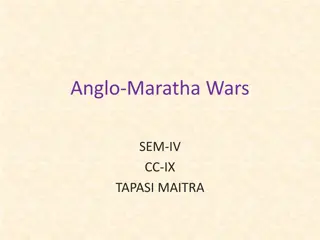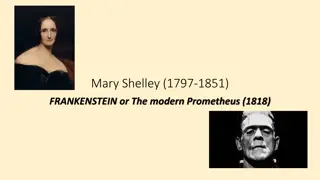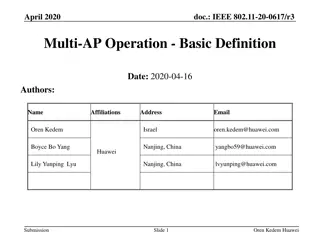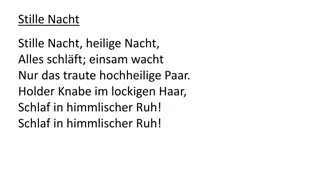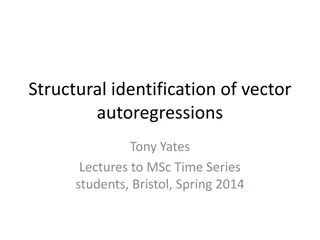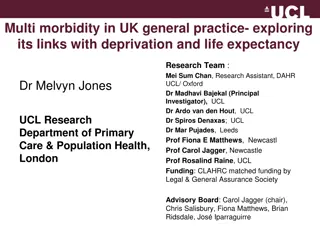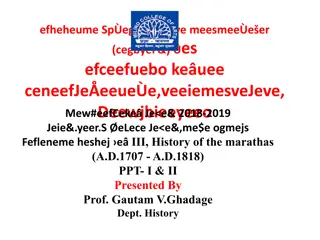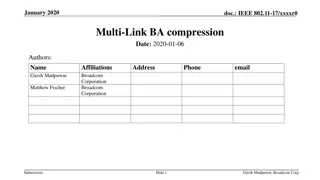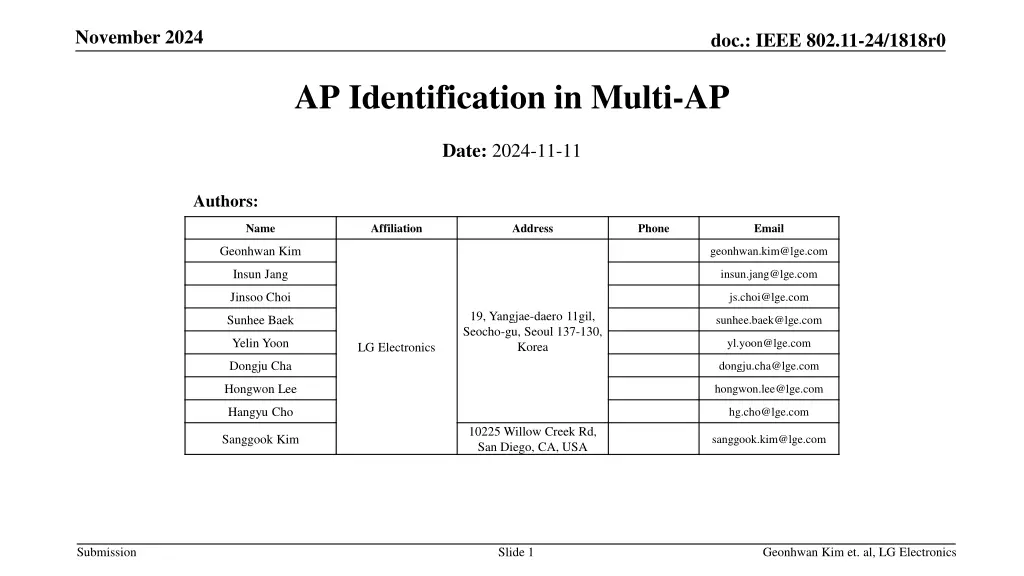
Efficient AP Identification Method in Multi-AP Coordination
Explore a proposed AP identification method in Multi-AP Coordination (MAPC) operations to enhance coordination between Access Points (APs). The method involves assigning unique AP IDs and utilizing AID12 subfields for efficient frame identification, ensuring seamless communication during negotiation/agreement phases in MAPC protocols.
Download Presentation

Please find below an Image/Link to download the presentation.
The content on the website is provided AS IS for your information and personal use only. It may not be sold, licensed, or shared on other websites without obtaining consent from the author. If you encounter any issues during the download, it is possible that the publisher has removed the file from their server.
You are allowed to download the files provided on this website for personal or commercial use, subject to the condition that they are used lawfully. All files are the property of their respective owners.
The content on the website is provided AS IS for your information and personal use only. It may not be sold, licensed, or shared on other websites without obtaining consent from the author.
E N D
Presentation Transcript
November 2024 doc.: IEEE 802.11-24/1818r0 AP Identification in Multi-AP Date: 2024-11-11 Authors: Name Affiliation Address Phone Email Geonhwan Kim geonhwan.kim@lge.com Insun Jang insun.jang@lge.com Jinsoo Choi js.choi@lge.com 19, Yangjae-daero 11gil, Seocho-gu, Seoul 137-130, Korea Sunhee Baek sunhee.baek@lge.com Yelin Yoon yl.yoon@lge.com LG Electronics Dongju Cha dongju.cha@lge.com Hongwon Lee hongwon.lee@lge.com Hangyu Cho hg.cho@lge.com 10225 Willow Creek Rd, San Diego, CA, USA Sanggook Kim sanggook.kim@lge.com Submission Slide 1 Geonhwan Kim et. al, LG Electronics
November 2024 doc.: IEEE 802.11-24/1818r0 Introduction To configure Multi-AP coordination (MAPC) between APs, each AP should first exchange its capabilities and requirements (i.e., negotiation/agreement) [1, 2]. Also, since one AP can establish coordination with multiple APs, an IDs can be assigned to identify them during negotiation. Based on the acquired information, MAPC-based schemes (e.g., Co-SR/BF/TDMA, etc.) has to be initiated by the sharing AP sending a Trigger frame. e.g., for the purpose of coordination announcement (i.e., polling phase) and/or coordination triggering [3]. Therefore, AP identification other than MAC address is required to identify participating APs and address the Trigger frame to the target shared AP. In this contribution, we propose an AP identification method in MAPC operation. During negotiations, each AP assign an (local) ?-bit AP ID to identify its participating APs. Starting AID can be defined to position the AP ID within the appropriate range of AID values. The receiving AP can know that the Trigger frame is sent to it through the TA field and the (Starting AID + ?-bit AP ID) value. Submission Slide 2 Geonhwan Kim et. al, LG Electronics
November 2024 doc.: IEEE 802.11-24/1818r0 AID12 subfield encoding In order for the receiving AP to identify the frame based on the TA field and AID11 or AID12 field, some AID12 values will need to be defined for AP identification. As shown in the AID12 subfield encodingtable [4], many values are already being used for associated STAs (0, 1 2007, 2046), unassociated STAs (2045), and padding (4095). There are also many reserved values that are not being used yet. To avoid misunderstandings on the legacy STA side and to use the AID11 and AID12 fields for AP identification, reserved values within 2008 2044 should be used. Submission Slide 3 Geonhwan Kim et. al, LG Electronics
November 2024 doc.: IEEE 802.11-24/1818r0 Use 11 or 12 bit AID value as AP ID The simplest identification method may be to use the AID11 or AID12 value itself to assign an AP ID. For example, AID12 subfield encoding table is modified and values between 2008 2044 are assigned to APs. These AID values are included in the frames transmitted during the MAPC negotiation/agreement procedure. AP ID = 2008 (to AP 2) AID12 subfield encoding AID12 subfield AP ID = 2010 (to AP 1) AP 1 AP 2 Description 1 2007 ... User Info field is addressed to an AP whose AID is equal to the value in the AID12 field 2008 2044 ... ... AP 3 However, since the AID12 field is rather long in itself, it seems unnecessary to use the 12 bit AID value as is for AP ID assignment during MAPC negotiation. Also, the number of APs that actually try to collaborate with other APs will probably not be that large. By defining a (local) AP ID less than 12 bits, the length of the AP ID field in the Multi-AP negotiation frame can be reduced. Submission Slide 4 Geonhwan Kim et. al, LG Electronics
November 2024 doc.: IEEE 802.11-24/1818r0 AP ID for MAPC Each AP can assign a ?-bit AP ID to the APs participating in MAPC through a negotiation/agreement. e.g., the AP that initiates the negotiation delivers the AP ID assigned to that recipient AP. If the receiving AP accepts the MAPC request, it responds by assigning an AP ID for the transmitting AP. So that both APs are aware of the AP ID assigned locally by the other AP. The mutually agreed AP ID can be used to identify the AP in subsequent MAPC operations. i.e., the Trigger frame transmitted to the participating AP(s) may include the corresponding AP ID in the AID12 field. The assigned AP ID can be interpreted as (?? ?? + ???????? ???), which matches the AID12 value. Submission Slide 5 Geonhwan Kim et. al, LG Electronics
November 2024 doc.: IEEE 802.11-24/1818r0 AID12 field configuration Assuming that the AP ID is defined as 4 bits, an AP ID can be assigned to up to 16 APs. There are many variations in configuring the AID11/12 field, depending on the size of the AP ID and the Starting AID value. e.g., for 4-bit AP IDs, 2008 2023, 2009 2024, ...., 2029 2044 can be used. AID11 or AID12 = 2008 (Starting AID) + 0 (AP ID) = 2008 AID11 or AID12 = 2008 + 1 (AP ID) = 2009 AP ID = 0 AP ID = 1 AID11 or AID12 = 2008 + 15 (AP ID) = 2023 AP ID = 15 AID11 or AID12 = 2029 (Starting AID) + 0 (AP ID) = 2029 AID11 or AID12 = 2029 + 1 (AP ID) = 2030 AP ID = 0 AP ID = 1 AID11 or AID12 = 2029 + 15 (AP ID) = 2044 AP ID = 15 Alternatively, an option could be considered to put the AP ID on ? consecutive bits including the LSB and fix the remaining bits to a specific value. Detailed examples are covered in the Appendix #1. Submission Slide 6 Geonhwan Kim et. al, LG Electronics
November 2024 doc.: IEEE 802.11-24/1818r0 Conclusion In this contribution, we propose an AP identification method for MAPC. Since AP identification is essential to configuring and operating Multi-AP, a method to identify APs participating in MAPC should be implemented. The simplest way is to identify the AP using the AID11 or AID12 value itself. However, using full 12-bit AID value to assign an AP ID during the negotiation/agreement procedure seems to be inefficient because only a small fraction of AID12 values will actually be used. Therefore, we can define an (local) AP ID used for MAPC negotiation and management. By defining a AP ID less than 12 bits, the size of the Multi-AP negotiation frame can be reduced. Submission Slide 7 Geonhwan Kim et. al, LG Electronics
November 2024 doc.: IEEE 802.11-24/1818r0 References [1] 23/1871, M-AP Coordinated Transmission framework [2] 24/0842, Multi-AP set configuration for C-TDMA [3] 24/0843, Some details on TXOP sharing in C-TDMA [4] Draft P802.11REVme_D7.0 Submission Slide 8 Geonhwan Kim et. al, LG Electronics
November 2024 doc.: IEEE 802.11-24/1818r0 Straw Poll 1 Do you agree to add the following text to the TGbn SFD? During multi-AP negotiation between two APs, an AP assigns a unique ID to the other AP. The ID is indicated as a numerical value. The size of the field including ID is TBD. NOTE: For example, the assigned ID is expected to be used to identify the corresponding AP in the AID12 field of the Trigger frame. NOTE: For example, the assigned ID is expected to be used to identify the corresponding AP in the AID11 field of the UHR NDP Announcement frame. Submission Slide 9 Geonhwan Kim et. al, LG Electronics
November 2024 doc.: IEEE 802.11-24/1818r0 Straw Poll 2 Do you agree to add the following text to the TGbn SFD? An AP, that transmits a Trigger frame as part of a transmission sequence in a M-AP coordinated transmission scheme, identifies another AP via an AP ID in the AID12 field of the User Info field of the frame where the AP ID is set to the Starting AID plus the ID that has been assigned to that another AP during multi-AP negotiation. The value of starting AID is TBD. Reference: Motion #135 Submission Slide 10 Geonhwan Kim et. al, LG Electronics
November 2024 doc.: IEEE 802.11-24/1818r0 Straw Poll 3 Do you agree to add the following text to the TGbn SFD? An AP, that transmits an UHR NDP Announcement frame as part of a sounding sequence in a M-AP coordinated transmission scheme, identifies another AP via an AP ID in the AID11 field of the STA Info field of the frame where the AP ID is set to the Starting AID plus the ID that has been assigned to that another AP during multi-AP negotiation. The value of starting AID is TBD. Reference: Motion #135 Submission Slide 11 Geonhwan Kim et. al, LG Electronics
November 2024 doc.: IEEE 802.11-24/1818r0 ? bits Appendix #1 AP ID remaining bits AID11 or AID12 field Ex) 4-bit AP ID can be mapped to 2016 2031; Requirements: MSB should be set to 0 (for AID12) & bits 5 10 (i.e., AID12[5:10]) should be set to 1. LSB MSB Ex 1) AID12 LSB MSB AP ID = 0 (0000) AP ID = 1 (1000) AP ID = 15 (1111) (LSB)00000111 1110(MSB) (LSB)10000111 1110(MSB) (LSB)11110111 1110(MSB) AID12 = 2016 AID12 = 2017 AID12 = 2031 xxxx 0111 1110 AP ID (4 bits) AID12: Ex 2) AID11 LSB AP ID = 0 (0000) AP ID = 1 (1000) AP ID = 15 (1111) (LSB)00000111 111 (LSB)10000111 111 (LSB)11110111 111 AID11 = 2016 AID11 = 2017 AID11 = 2031 xxxx 0111 111 AP ID (4 bits) AID11: Submission Slide 12 Geonhwan Kim et. al, LG Electronics

